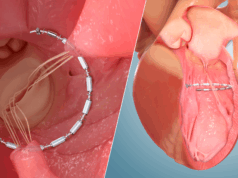
Two meta-analyses comparing the use of intravascular imaging to angiography for the guidance of percutaneous coronary intervention (PCI) provide fresh insights into the impact of intravascular imaging guidance for percutaneous coronary intervention on patient survival and outcomes.
Both analyses, one from researchers in Europe and another from a team in the USA, include data from more than 20 randomised trials comparing the outcomes of PCI guided by coronary angiography or intravascular imaging in the form of optical coherence tomography in the form of intravascular ultrasound (IVUS) or optical coherence tomography (OCT).
The first, published online ahead of print in Circulation and authored by Daniele Giacoppo and Claudio Laudani (both University of Catania, Catania, Italy) and colleagues, includes data from more than 15,000 patients, using studies to have compared at least two PCI guidance strategies.
“The analysis of available evidence from randomised trials indicates that IVUS-guided PCI was associated with reduced any-type and ischaemia-driven target lesion revascularisation compared with invasive coronary angiography-guided PCI, whereas no significant differences were observed between OCT-guided and invasive coronary angiography-guided PCIs for the same outcomes,” the study’s authors observe. However, they add, “neither IVUS- nor OCT-guided PCI was associated with reduced myocardial infarction and target vessel myocardial infarction compared with invasive coronary angiography-guided PCI”.
Previous meta-analyses predating numerous large-scale trials, have focused upon a single intravascular imaging modality, have pooled observational studies and trials using outdated devices, and used simpler meta-analytic methodology, relying generally on frequentist statistics, pairwise comparisons, and a very limited number of sensitivity analyses, Giacoppo and Laudani write. Their analysis incorporates some of the latest randomised trial data to have emerged, as well as employing frequentist random-effects network meta-analyses and Bayesian random-effects models to compare the imaging modalities.
Among the recent trials to have been included in the analysis are the RENOVATE-COMPLEX-PCI trial, a 1,639-patient randomised trial in which it was shown that the use of intravascular imaging guidance for PCI in patients with complex coronary artery lesions led to a lower risk of a composite of death from cardiac causes, target vessel-related MI or clinically driven target revascularisation than procedures using only angiography.
Giacoppo and Laudani describe this as a “prelude” to the results of both the ILUMIEN IV trial, looking at OCT-guided PCI in high-risk patients, and the OCTOBER trial, which assessed OCT-guidance in bifurcation lesions; both of which were presented at the European Society of Cardiology (ESC) 2023 congress (25–28 August, Amsterdam, The Netherlands).
“The ILUMIEN IV trial, including a total of 2,487 patients with clinical and angiographic high risk criteria randomly assigned to OCT- or invasive coronary angiography-guided PCI, showed no significant difference in two-year target lesion failure between guidance strategies. In contrast, the OCTOBER trial including 1201 patients with bifurcation disease randomly assigned to OCT- versus invasive coronary angiography-guided PCI showed a significant reduction in major adverse cardiac events at two years associated with OCT guidance,” the researchers write.
These recent data have added growing weight to the calls from proponents of intravascular imaging technology who say that its use optimises outcomes for PCI. A state-of-the-art review paper published in the Journal of the American College of Cardiology (JACC) in April last year recommended that all cardiac cath labs should have the capability for intravascular imaging to augment conventional angiography.
Research presented at the American College of Cardiology (ACC) 2023 Scientific Sessions (4–6 March, New Orleans, USA) has pointed to a growing use of intravascular imaging in the USA, albeit only rising to as many as 15.4% of cases by 2019, and some commentators have described uptake of the technology as having been slow.

These latest trials are included in the second of the two new analyses, authored by Gregg Stone (Icahn School of Medicine at Mount Sinai, New York, USA) and colleagues, published this week in The Lancet. Stone et al’s study examined 22 trials in total, including data from close to 16,000 patients, dating up to September 2023. The primary endpoint of the analysis was target lesion failure, defined as the composite of cardiac death, target vessel-MI, or target lesion revascularisation, assessed in patients randomly assigned to intravascular imaging guidance versus angiography guidance.
“Our study, representing a synthesis of all early and recent clinical studies, has shown for the first time that the routine use of intravascular imaging guidance improves survival and enhances all aspects of the safety and effectiveness of coronary stenting, even with excellent contemporary drug-eluting stents,” said Stone.
“Prior studies had shown benefits of intravascular imaging, but never to this extent. The addition of four recent trials in which 7,224 patients were enrolled now shows that intravascular imaging reduces all-cause death and all heart attacks across the wide range of patients who undergo stent treatment. As such, the routine use of intravascular imaging to guide stent implantation is one of the most effective therapies we have to improve the prognosis of patients with coronary artery disease.”
During follow-up ranging from six to 60 months with a mean of two years, patients who received intravascular imaging guidance experienced a 25% reduction in all-cause death, 45% reduction in cardiac death, 17% in all MIs, and 48% reduction in stent thrombosis compared with angiography guidance, Stone et al report. The study also found that intravascular imaging reduced target vessel-MI by 18% and target lesion revascularisation by 28%. The outcomes were similar for OCT-guided and IVUS-guided PCI, the researchers report.
“With these results, we now need to shift from performing more studies to determine whether intravascular imaging is beneficial, to increasing efforts to overcome the remaining impediments to the routine use of OCT and IVUS, including better training of physicians and staff and increasing reimbursement,” Stone said. “In this regard, we now have better “hard evidence” that intravascular imaging guidance of PCI procedures makes a greater impact to improving our patients’ lives than other routine therapies which are more widely used and reimbursed.”













